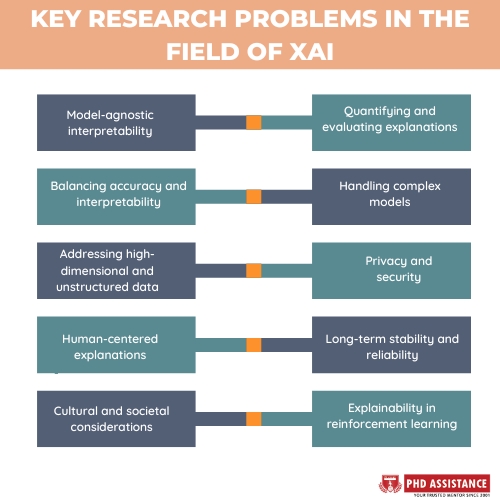Identifying research problems in Explainable Artificial Intelligence (XAI) methods
The rapid growth and use of artificial intelligence (AI)-based systems have raised research problems regarding explainability. Recent studies have discussed the emerging demand for explainable AI (XAI); however, reviewing explainable artificial intelligence projects from an end user’s perspective can provide a comprehensive understanding of the current situation and help close the research gap.
The purpose of this blog was to perform a review of explainable AI from the end user’s perspective and to synthesize the findings. To be precise, the objectives were to 1) identify the dimensions of end users’ explanation needs, 2) investigate the effect of explanation on end user’s perceptions, and 3) identify a research problem and propose future research agendas for XAI, particularly from end users’ perspectives based on current knowledge.
Introduction

What are Explainable AI XAI methods?
Explainable Artificial Intelligence (XAI) is an important area of research that focuses on developing methods and techniques to make AI systems more transparent and understandable to humans. Identifying research problems in XAI methods involves recognizing the current challenges and limitations in achieving explainability in AI systems.
Here are some key research problems in the field of XAI:
- Model-agnostic interpretability: Many XAI methods are specific to certain types of models, such as decision trees or neural networks. One research problem identification step is to develop model-agnostic interpretability techniques that can be applied to a wide range of AI models, making it easier to explain their behaviour.
- Quantifying and evaluating explanations: While XAI methods generate explanations for AI system outputs, there is a need for robust and standardized evaluation metrics to assess the quality and effectiveness of these explanations. Developing evaluation frameworks considering human perception and cognitive biases is a challenging problem identification research.
- Balancing accuracy and interpretability: There is often a trade-off between the accuracy and interpretability of AI models. The importance of research problem must develop methods that balance these two aspects, allowing for accurate predictions and understandable explanations.
- Handling complex models: As AI models become increasingly complex, such as deep neural networks with millions of parameters, providing meaningful explanations becomes more challenging. Research design is needed to develop XAI methods to effectively handle and explain these complex models’ behaviour.
- Addressing high-dimensional and unstructured data: Many real-world datasets are high-dimensional and unstructured, such as images, text, or sensor data—explainable artificial intelligence examples methods needed to handle and explain such data effectively. Research is needed to develop techniques to extract meaningful explanations from these data types.
- Check out our Sample Research Problem for the Project to see how the problem statement is constructed.
- Privacy and security: Explainability methods should also consider privacy and security concerns. Developing XAI techniques that can provide interpretable explanations while preserving sensitive or private information is a significant research problem.
- Human-centred explanations: XAI methods should provide understandable and meaningful explanations to humans. Research is needed to explore how different types of users (e.g., domain experts, non-experts) interpret and utilize explanations and how to tailor explanations to specific user needs.
- Long-term stability and reliability: AI models can evolve and change over time due to updates, data drift, or concept drift. XAI methods must adapt and provide consistent and reliable explanations in such scenarios. Research is required to develop techniques that can handle explanations’ long-term stability and reliability.
- Cultural and societal considerations: Cultural and societal factors can influence explanations provided by AI systems. Finding a research problem is needed to understand the impact of cultural biases on explanations and develop Explainable AI tools that are culturally sensitive and fair.
- Explainability in reinforcement learning: Reinforcement learning algorithms often involve complex decision-making processes, and providing explanations for their actions and policies is a challenging research problem. Developing XAI methods specific to reinforcement learning is an important area of exploration.
These research problems highlight some of the ongoing challenges in the field of XAI. Addressing these issues will contribute to the development of more transparent, interpretable, and trustworthy AI systems.
- Check out our study guide to learn more about research problem identification. The importance of identifying a research problem for a PhD Dissertation?
Critical analysis of future research agendas
This section focuses on challenging and complicating future research directions in XAI. It examines present knowledge and suggests ways to enhance it. The research investigates XAI methodological, conceptual, and development difficulties, categorizing them into three theme categories: standardized practice, representation, and overall influence on humans. Emerging AI research topics for beginners are developed from previously undiscovered regions and created in terms of their potential relevance to establish particular and realistic research paths [1].
Conclusion
AI can potentially change a variety of industries if used appropriately. However, the AI community must solve the explainability barrier previously absent from AI-based ecosystems. This blog explores XAI from the end user’s standpoint, establishing aspects of explanation quality from empirical investigations. End-user adoption and use of AI-based technologies can be motivated by the impacts of XAI. Future research directions, as well as a complete framework, have been outlined. As the dimensions affect trust, understandability, fairness, and transparency, there is an increasing demand for XAI.
About PhD Assistance
PhD Assistance’s expert team comprises dedicated researchers who will accompany you, think from your experience, and identify possible study gaps for your PhD research topic. We guarantee that you have a solid understanding of the context and previous research undertaken by other researchers, which will help academics identify a research problem and provide resources for building a persuasive argument with their supervisor.
References
- Haque, AKM Bahalul, AKM Najmul Islam, and Patrick Mikalef. “Explainable Artificial Intelligence (XAI) from a user perspective: A synthesis of prior literature and problematizing avenues for future research.” Technological Forecasting and Social Change186 (2023): 122120.
- Ali, Sajid, et al. “Explainable Artificial Intelligence (XAI): What we know and what is left to attain Trustworthy Artificial Intelligence.” Information Fusion(2023): 101805.



